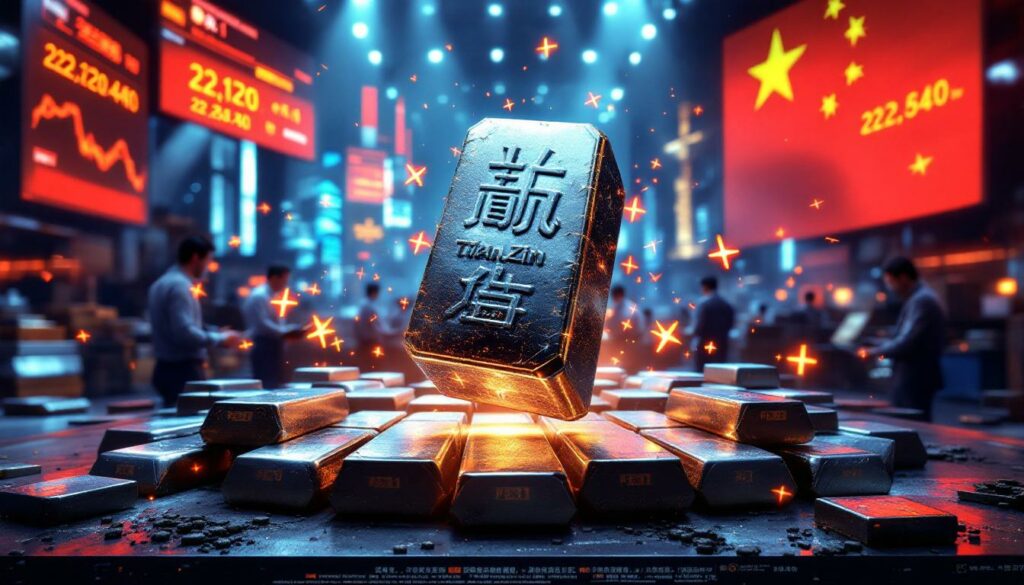What's Happening in the Tianjin Zinc Futures Market?
The Tianjin zinc futures market has experienced significant movement recently, with prices showing distinctive patterns across different zinc grades and brands. Trading activity has been notably influenced by broader market sentiment, creating a complex landscape for both traders and downstream buyers.
Current Price Movements and Trading Ranges
Current transactions in the Tianjin zinc futures market reveal a structured pricing hierarchy, with premium brands commanding higher prices. According to the latest Shanghai Metal Market (SMM) data from July 14, 2025, mainstream #0 zinc ingot transactions ranged between 22,120-22,240 yuan/mt, while premium Zijin zinc traded slightly higher at 22,150-22,280 yuan/mt.
Lower-grade #1 zinc ingot transactions settled at 22,010-22,120 yuan/mt, reflecting the market's quality-based pricing system. Meanwhile, Huludao zinc—known for its high purity standards—commanded a substantial premium at 23,080 yuan/mt.
Regional pricing dynamics show the Tianjin market trading at approximately 40 yuan/mt discount compared to Shanghai, highlighting geographical supply-demand imbalances that influence local pricing structures.
Premium/Discount Structure Against 2508 Contract
The relationship between physical zinc prices and futures contracts serves as a critical market indicator. Current premium/discount structures against the benchmark 2508 futures contract reveal:
- Ordinary #0 zinc: -10 to +10 yuan/mt (ranging from slight discount to premium)
- Premium Zijin zinc: +20 to +50 yuan/mt (consistent premium)
- Xin Zijin: -10 yuan/mt (small discount)
- Chihong: -10 to 0 yuan/mt (discount to parity)
- Hongye: Trading at parity with the futures contract
These differentials reflect not only brand reputation but also market liquidity and physical demand dynamics. The 2508 contract (August 2025 futures) serves as the benchmark against which physical premiums or discounts are calculated, with premium brands like Zijin commanding higher prices due to standardized purity levels and reliability.
"The physical premium structure against futures contracts provides valuable insight into immediate market tightness or oversupply conditions," notes SMM analysts. "Current patterns suggest a relatively balanced market for premium brands but weaker conditions for standard grades."
Why Are Zinc Futures Pulling Back?
The recent pullback in zinc futures has created ripple effects throughout the physical market, influencing trader behavior and downstream purchasing patterns.
Market Sentiment Analysis
The SMM midday review from July 14 indicates a significant pullback in futures has amplified bearish sentiment among downstream buyers. This hesitancy has translated into limited restocking activity despite price adjustments, suggesting market participants anticipate potential further declines.
The persistent bearish outlook has created a self-reinforcing cycle: futures pullbacks discourage buying, which in turn reduces physical demand, potentially pressuring prices further. This sentiment mirrors broader macroeconomic concerns, with China's June 2025 Manufacturing PMI registering at 49.5—below the 50.0 expansion threshold.
Traders have responded to the challenging environment by reducing premiums to facilitate sales, highlighting their efforts to maintain transaction volumes amid weakening demand. According to SMM analysis: "Downstream buyers maintained bearish sentiment, leading to sluggish overall market activity and price-sensitive purchasing behavior."
Market Activity Indicators
Transaction patterns reveal an important shift in market dynamics—most exchanges are occurring between traders rather than involving end-users. This trader-to-trader activity suggests inventory repositioning rather than genuine consumption demand, a classic indicator of market uncertainty.
Overall trading volume remains subdued, with participants adopting a cautious, wait-and-see approach. The price sensitivity displayed by buyers indicates they are operating on minimum inventory levels, purchasing only as absolutely necessary rather than building stocks.
Similar futures pullbacks occurred in Q2 2025 during China's manufacturing contractions, suggesting a correlation between industrial activity metrics and zinc market sentiment. The current situation appears to follow this established pattern, with limited signs of immediate reversal.
How Does the Tianjin Zinc Market Compare to Other Metals?
Understanding Tianjin's zinc market requires contextualizing it within broader metal markets and regional dynamics.
Regional Market Comparisons
The Tianjin zinc market currently trades at approximately 40 yuan/mt discount compared to Shanghai, reflecting regional supply-demand imbalances. This discount has remained relatively stable despite market fluctuations, suggesting structural rather than temporary factors.
Premium brand differentials display remarkable consistency across regions, with Zijin maintaining its 20-50 yuan/mt premium even amid broader market volatility. This stability highlights the importance of brand reputation and quality consistency in determining price structures.
By comparison, the Shanghai-Tianjin aluminum premium stood at +60 yuan/mt in July 2025, according to SMM data, demonstrating how regional price disparities can vary significantly across different base metals. These differences often reflect local industrial concentrations, logistical considerations, and warehouse inventory positions.
Cross-Metal Market Context
Zinc's recent price movement exists within a larger metals complex experiencing varied performance. While zinc futures have pulled back significantly, other industrial metals like copper have shown greater resilience, supported by different copper price insights.
The price spread between #0 and #1 zinc grades has maintained consistency at approximately 110-120 yuan/mt, indicating that quality differentials remain stable even when absolute prices fluctuate. This consistency suggests that fundamental quality valuations persist regardless of broader market sentiment.
Zinc's relative positioning against other industrial metals provides important context for traders navigating cross-metal strategies or downstream consumers balancing material costs across their supply chains. Current zinc/aluminum and zinc/copper price ratios have shifted slightly in favor of zinc due to its recent pullback, potentially affecting material substitution decisions in certain applications.
What Factors Are Influencing Zinc Market Dynamics?
Multiple factors converge to shape the current zinc market landscape, from production economics to consumption patterns.
Supply-Side Considerations
The global zinc concentrate supply has shown signs of easing, with the International Lead and Zinc Study Group (ILZSG) reporting that global zinc mine output increased 3.2% year-over-year in Q1 2025. This improved raw material availability has alleviated some smelter input constraints but may contribute to refined metal oversupply.
Smelter operations remain a critical factor, with utilization rates influencing immediate market availability. While transcript data doesn't specify current operating rates, historical patterns suggest that Chinese smelters adjust production based on treatment charge levels and power cost considerations.
Inventory positions at key warehouses provide another supply-side indicator. Shanghai Futures Exchange (SHFE) and London Metal Exchange (LME) stock movements often precede price trends, with increasing inventories typically signaling weakening market conditions.
China's import/export dynamics also influence domestic availability, with import volumes of zinc concentrate serving as a leading indicator of future refined production. Recent trade war effects merit monitoring for shifts that could impact the domestic supply-demand balance.
Demand-Side Factors
Downstream manufacturing activity levels directly impact zinc consumption, with galvanizing operations—which account for approximately 50% of zinc usage—serving as a key demand barometer. Recent data from the China Association of Automobile Manufacturers (CAAM) indicates automotive zinc consumption fell 4% month-over-month in June, aligning with the observed downstream caution.
Construction and infrastructure projects represent another major zinc consumption channel. The typical Q3 monsoon season historically reduces construction activity, tempering galvanized steel demand during this period. Any delays or accelerations in government infrastructure initiatives could significantly influence zinc demand trajectories.
Seasonal factors also affect purchasing patterns, with many fabricators traditionally reducing inventory levels during summer months. The current limited restocking behavior observed in Tianjin appears consistent with these seasonal norms, though perhaps more pronounced due to the bearish sentiment.
"The interplay between smelter economics and downstream demand ultimately determines market direction," notes SMM analysis. "Current signals suggest supply adequacy meeting restrained demand, creating little immediate pressure for price recovery."
What Are the Technical Indicators Suggesting?
Technical analysis provides additional perspective on zinc price movements and potential future directions.
Price Support and Resistance Levels
While specific technical levels aren't detailed in the transcript, historical zinc trading patterns suggest important support zones around the 22,000 yuan/mt level for physical #0 zinc in Tianjin. This approximate level has provided support during previous market corrections, though sustained trading below this threshold could signal further weakness.
Resistance appears to be forming around the 22,300 yuan/mt level, with recent transactions struggling to break convincingly above this range. This ceiling may require improved downstream demand fundamentals to overcome.
Recent price action has shown decreased volatility within a narrowing range, potentially indicating market indecision before the next directional move. The bearish sentiment observed in trader behavior suggests downside risks remain more prominent in the near term.
Futures Market Analysis
The futures market pullback has established an important reference point for physical market participants. Analyzing the 2508 contract's behavior—including open interest, volume patterns, and technical indicators like relative strength index (RSI)—could provide valuable signals about market momentum.
The relationship between near-dated and forward contracts (the forward curve structure) offers insight into market expectations. Any shift from contango (forward premiums) to backwardation (forward discounts) would signal changing perceptions about future supply-demand balances.
Speculative positioning versus commercial hedging activities also influences price discovery. Excessive speculative interest can amplify price movements beyond fundamental justifications, while predominant commercial activity typically keeps prices more aligned with physical market realities.
Zinc has historically displayed seasonal trading patterns, with Q3 often showing relative weakness. Current technical signals appear consistent with this seasonal tendency, suggesting that counter-seasonal strength would require significant fundamental catalysts.
How Might the Zinc Market Develop in Coming Weeks?
Forecasting market direction requires synthesizing fundamental, technical, and sentiment factors to identify the most likely scenarios.
Short-Term Outlook Considerations
The persistent bearish sentiment among downstream buyers remains a key limiting factor for price recovery. Without improved manufacturing demand signals—particularly from galvanizing operations—physical buying interest may remain opportunistic rather than strategic.
Supply-demand balance expectations appear tilted toward adequacy or slight surplus in the near term, with global zinc mine output growth potentially translating to increased refined production. This fundamental backdrop suggests limited immediate upward price pressure.
Seasonal factors entering Q3 typically constrain construction-related zinc demand, aligned with current market conditions. Any deviation from these seasonal patterns would merit attention as a potential signal of changing fundamentals.
Macroeconomic indicators will continue influencing industrial metals broadly. China's upcoming manufacturing PMI releases, industrial production data, and property market metrics may provide important context for zinc demand expectations.
Key Factors to Monitor
Several specific indicators warrant close monitoring for early signs of market direction changes:
-
Downstream buying behavior: Any shift from cautious, minimal purchasing to more substantial restocking would signal improving confidence.
-
Trader positioning: Changes in how traders manage inventories and premiums/discounts could indicate evolving expectations.
-
Warehouse inventories: Accelerating stock draws or builds at key exchanges (SHFE/LME) often precede price movements.
-
Policy developments: Government infrastructure initiatives or environmental regulations affecting smelter operations could alter market fundamentals.
-
Export dynamics: Changes in China's export tax policies for zinc alloys (potentially under consideration by the Ministry of Finance) could redirect material flows.
Investors interested in zinc and other metals should also consider reviewing comprehensive iron ore price trends and the potential tariff impact analysis to develop a more holistic view of the commodities landscape.
Disclaimer: Market forecasts involve inherent uncertainty. The factors discussed represent potential influences rather than definitive predictions. Market participants should conduct their own analysis and risk assessment.
FAQ About the Tianjin Zinc Market
What is causing the bearish sentiment in the downstream zinc market?
The persistent bearish sentiment appears driven by several converging factors. The significant futures market pullback has created anticipation of potentially lower prices, encouraging buyers to delay purchases. This wait-and-see approach is reinforced by broader manufacturing slowdown signals, including sub-50 PMI readings, suggesting weaker overall industrial demand.
Additionally, seasonal factors entering Q3 typically reduce construction and infrastructure activity, traditionally tempering galvanized steel demand. The combination of these price, economic, and seasonal factors has created a cautious purchasing environment where buyers operate on minimal inventory levels.
How do premium zinc brands differ from standard grades?
Premium zinc brands like Zijin command higher prices (currently +20 to +50 yuan/mt) due to several quality-related advantages:
-
Higher purity levels: Premium brands typically offer zinc content of 99.995% or higher, exceeding the 99.99% standard for #1 zinc.
-
Consistency in specifications: Premium producers maintain stricter quality control, ensuring more predictable performance in demanding applications.
-
Lower impurity levels: Reduced concentrations of elements like lead, cadmium, and iron make premium zinc preferable for specialized uses like die-casting and electronics.
-
Brand reputation: Established reliability creates market confidence, with certain brands recognized for consistent quality over time.
These quality differentials make premium brands particularly valuable for applications requiring high-performance materials, justifying their consistent price premiums even during market fluctuations.
What is the significance of the discount between Tianjin and Shanghai markets?
The current 40 yuan/mt discount in Tianjin relative to Shanghai reflects several important market dynamics:
-
Regional supply-demand balances: The discount suggests relatively weaker demand or better supply availability in the Tianjin region compared to Shanghai.
-
Logistical considerations: Transportation costs between regions create natural price differentials, with the discount partially reflecting delivery costs between markets.
-
Industrial concentration differences: Shanghai's proximity to manufacturing hubs may create stronger local demand, supporting relatively higher prices.
-
Warehouse inventory positions: Different stock levels between regions influence local pricing, with higher inventories typically pressuring regional prices.
Regional price differentials serve as important indicators for traders considering arbitrage opportunities and for consumers optimizing sourcing strategies across different Chinese markets.
How do futures contract premiums and discounts affect physical market trading?
The relationship between physical zinc prices and futures contracts (like the 2508 contract) provides critical market signals:
-
Premium to futures (backwardation): When physical prices trade above futures prices, it typically indicates immediate supply tightness or strong spot demand. This incentivizes inventory releases and discourages storage.
-
Discount to futures (contango): Physical prices below futures levels suggest immediate oversupply or weak spot demand. This structure encourages inventory building if the spread exceeds storage costs.
-
Brand-specific differentials: As seen with Zijin's premium (+20 to +50 yuan/mt) versus Xin Zijin's discount (-10 yuan/mt), these spreads reflect quality differences and brand preferences.
Traders and consumers closely monitor these relationships to optimize buying strategies, with many industrial users increasing purchases when physical discounts widen and reducing them when premiums expand. The current mixed structure (premiums for high-quality brands, discounts for others) suggests a market differentiating strongly based on quality rather than facing uniform tightness or oversupply.
Investors seeking to understand commodity markets more broadly should consult a comprehensive commodity investment guide to develop effective strategies across different market conditions.
Market Data Summary Table
| Zinc Product Type | Price Range (yuan/mt) | Premium/Discount vs 2508 Contract |
|---|---|---|
| #0 Zinc Ingot | 22,120-22,240 | -10 to +10 yuan/mt |
| Zijin Zinc | 22,150-22,280 | +20 to +50 yuan/mt |
| #1 Zinc Ingot | 22,010-22,120 | Not specified |
| Huludao Zinc | 23,080 | Not specified |
| Xin Zijin | Not specified | -10 yuan/mt |
| Chihong | Not specified | -10 to 0 yuan/mt |
| Hongye | Not specified | At parity |
Market Insight: The significant futures pullback combined with traders lowering premiums to facilitate sales suggests a market adjusting to weaker demand conditions, with potential for continued price pressure if downstream sentiment remains bearish.
The Tianjin zinc futures market continues to operate within a complex environment where quality differentials remain important despite overall price pressure. Premium brands maintain their value proposition even as the broader market navigates uncertain demand conditions. Traders and consumers alike must balance short-term price considerations against longer-term supply security needs when developing their market strategies.
Want to Stay Ahead of Major Mineral Discoveries?
Discovery Alert's proprietary Discovery IQ model instantly notifies you of significant ASX mineral discoveries, turning complex data into actionable investment opportunities. Explore how historic discoveries have led to exceptional returns by visiting our dedicated discoveries page and start your 30-day free trial today.




